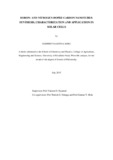Boron- and Nitrogen-Doped Carbon Nanotubes: Synthesis, Characterization and Application in Solar Cells
Abstract
The investigations in this project focused on the synthesis and characterization of boron- and nitrogen-doped carbon nanotubes (B- and N-CNTs), and the subsequent application of the doped-CNTs in organic solar cells (OSCs). The CNTs (B-CNTs and N-CNTs) were synthesized by using a floating catalyst chemical vapour deposition method with either ferrocene or its derivatives as the catalysts. A novel ferrocenyl derivative, namely, (4-{[(pyridin-4-yl)methylidene]amino}phenyl)-ferrocene, was synthesised by a mechanochemical solvent-free method and its crystal structure was also determined. The ferrocenyl derivative was obtained in high yields (94%) within a short reaction time (30 min). To synthesise N-CNTs, this ferrocenyl derivative was used as a catalyst, nitrogen source as well as an extra source of carbon. To synthesize B-CNTs, ferrocene was used as the catalyst, triphenylborane was the boron source as well as an extra source of carbon at 900 °C. The main carbon source was either toluene or acetonitrile, where applicable, in all CNT synthesis reactions.
The shaped carbon nanomaterials formed were characterized by means of transmission electron microscopy, scanning electron microscopy, high resolution transmission electron microscopy, electron dispersive X-ray spectroscopy, Raman spectroscopy, thermogravimetric analysis and X-ray photoelectron spectroscopy (XPS). In addition, a vibrating sample magnetometer, four probe conductivity measurement instrument, and an inverse gas chromatography surface energy analyser were used for B-CNT analysis. Formation of bamboo compartments in N-CNTs and cone structures in B-CNTs was a preliminary indication that boron and nitrogen were successfully doped in the hexagonal carbon network of carbon nanotubes (CNTs). XPS was used to ascertain the bonding environment of boron and nitrogen in the carbon network.
Boron in the B-CNTs was quantified with inductively coupled plasma-optical emission spectroscopy, while the nitrogen content in the N-CNTs was determined by elemental analysis. The amount of boron incorporated was found to be directly proportional to the percentage by weight of the boron-containing precursor used. At the same time, it was also observed that the amount of boron incorporated had an effect on the conductivities, dispersive surface energies and ferromagnetic properties, among other physicochemical
properties, of the B-CNTs. For N-CNTs, the amount of nitrogen incorporated was found to be dependent on synthesis temperature and the amount of nitrogen in the precursors. A temperature of 850 °C and acetonitrile as a carbon source, as well as an extra source of nitrogen, were found to be the best conditions in this study. This resulted in high nitrogen incorporation of about 17.57 at.% and high yield of ≈85% of carbon nanotubes in the total mass of the products obtained.
The B-CNTs or N-CNTs were then used to synthesize nanocomposites with poly(3-hexylthiophene) [P3HT] by either in situ polymerization or direct solution mixing. The nanocomposites were characterized with electron microscopy, UV-Vis spectrophotometry, and photoluminescence spectrophotometry. These nanocomposites were subsequently mixed with a fullerene derivate, [6,6]-phenyl C61 butyric acid methyl ester, to form donor-acceptor components in the photoactive layer in OSCs. Nanocomposites that were synthesized by in situ polymerization method performed better than those by direct solution mixing. Organic photovoltaic cell devices were fabricated on indium tin oxide coated glass substrates which were coated with a very thin layer of a hole transport layer, namely, 3,4-ethylenedioxythiophene:poly (styrenesulphonate). The nanocomposite photoactive layer of the devices was spin coated from a chloroform based solution. Finally, an ultra-thin layer of lithium fluoride and a 60 nm aluminium counter electrode were thermally evaporated in a vacuum.
The electrical properties of the fabricated solar cell devices were characterized by using a standard solar simulator operating at air mass (AM) of 1.5 at a light intensity of 100 mW cm-2. Important cell parameters, such as, fill factor (FF) and efficiency (ɳ) were determined from the current-voltage characteristics of the devices. The effects of B-CNTs or N-CNTs in the photoactive layer were studied and then compared with a standard device structure without doped-CNTs. Several techniques such as transient absorption spectroscopy (TAS) and atomic force microscopy (AFM) were used to understand the effects of B-CNTs or N-CNTs as part of the photoactive layer. The TAS technique was used to determine the yield and lifetime of the photo-generated charge carriers. This was compared with the power output (or ɳ) of the cell devices. AFM was used to study the morphology of the photoactive layer with B-CNTs or N-CNTs films on the substrates.
Doped-CNTs were also tested as charge extracting layer under various device configurations. The position of B- or N-CNTs in the photoactive layer was altered whereby a thin film of B- or N-CNT/P3HT was spin coated next to the hole or electron collecting electrodes. B-CNTs had a positive Hall coefficient and their film was coated close to the ITO electrode, while N-CNTs had negative coefficient and the film was placed close to the Al counter electrode. The short circuit current density and ɳ improved by 31% and 141%, respectively, for the devices with B-CNTs. While, in the case of N-CNTs, the respective values changed by 35% and 38%, respectively. B- or N-CNTs in the photoactive layer were found to improve the absorption of the polymer, the lifetime of the photo-generated free charge carriers and, also, the charge transport properties. The open circuit voltage was found to decrease in some devices which was attributed to recombination.
This work has shown that incorporation of doped-CNTs in the photoactive layer, markedly improves the photovoltaic properties of organic solar cells.

